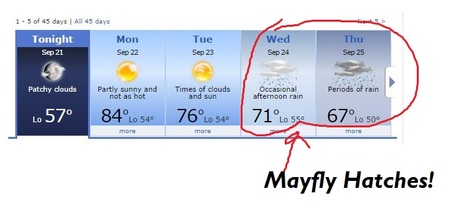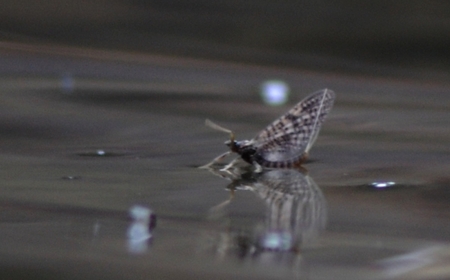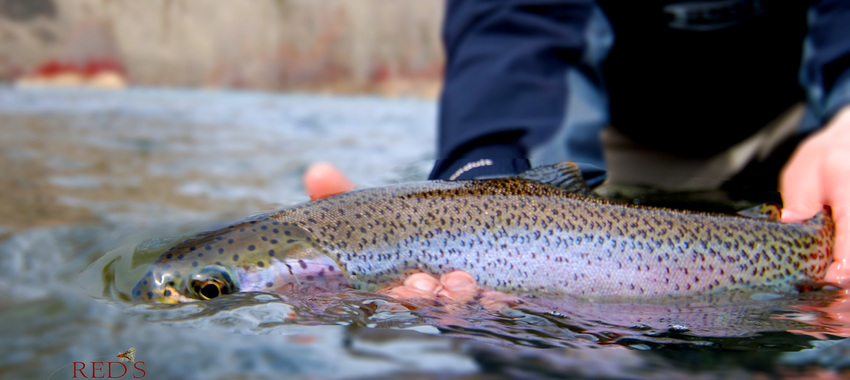Yakima River Fishing Report
September 21, 2014
There are a lot of fishing options right now! It is easy to forget just how amazing our home water, the Yakima River is this time of year. I have seen more old faces, worn out waders, and die hard anglers this past week than half the year combined! It seems like this is the time of year that all the old timers come out to play. The water is down, the fish are up, and it is the best wade fishing of the year. The river is down to about 1,200 cfs in the Yakima Canyon, which is nearly its low point for the year. This makes the wade fishing ideal. Whether you are on a guided trip or not, try to take advantage of this low water and do some fishing on foot. It just feels right.



Parachute Split Wing Adams Dry Fly - Go heavy on #16's and 18's for fall. There will be some demand for #14's too.
We haven't posted many reports lately because frankly conditions haven't been changing much. This constant high pressure has brought us amazing sunshine over the past 2 weeks. That is all changing this week and for anglers that don't mind wearing waders this could spur some hatches and promote dry fly fishing.
Weather Forecast for this week:

It seems like this time of year anytime you have a long period of sunshine and then get a damp, cloudy, and rainy day we get our first batch of fall Mayfly hatches. There will be a lot of various insects that hatch including some Olive Caddis as well (size 18 ish). You will need to be prepared with a variety of Mayfly patterns in addition to some October Caddis dry flies, especially if you fish the evening time.

How to Fish Mayfly Dry Flies
I will make this short, basic, and direct. If you are going to be successful with Mayfly dry flies you will most likely need to see fish rising. Hunt with your eyes, be patient, and when you find a decent trout feeding focus on that one fish and single it out. Even if there are 6 fish, focus on that one fish! Fly selection is semi-important but your leader tippet combo combined with your drift are more important. You will need a PERFECT drift most of the time. In the fall trout tend to feed on Mayflies in relaxed seamlines and tailout flats rather than choppy riffles. While this might sound easy the trout can see your fly, leader, and drift much better.
Once you find a fish sipping flies, cast your fly 4-8' above the fish depending on the spot and make your first few drifts just short of the fish and figure the currents out. NEVER make your first drift over the fish and NEVER EVER EVER EVER make it drift long. This is a rookie mistake. Make the fish move slightly towards you to get the fly. Simple. The fly looks more real, the tippet is not an issue, and since the fish is probably sitting in an invisible seamline you won't get drag like you would a few inches past the fish.
Stay calm and don't over fish it! It is kind of like duck calling, too much calling just pushes 'em away. We all have that buddy though that blows that darn call like they're at a friggin' U of Oregon game. Super annoying. Anyway, make your first drift just short figure out the currents. Give the fish a few seconds between casts but try to be quick enough to build a rhythm. If the fish doesn't take the bug, take a deep breath, drift it again. I give a fish 6 perfect drifts and then I'll change flies.
Here is an article that you should read if you plan to fish the Yakima this October.
Dry Flies:

Parachute Split Wing Adams Dry Fly - Go heavy on #16's and 18's for fall. There will be some demand for #14's too.
Pheasant Tail Cripple Dry Fly - Use this when you can't generate strikes and you are targeting feeding fish. #18's
Nymphs:
Super Sinker #16 - Put this under an October Caddis Dry Fly
-
I love these reports. Some of the only decent ones on the yakima around. I have fished the upper stretches of the Yak the past two weeks and found massive trout of both species sipping mayflies. Now that the rain is here and overcast the past two days were crazy good. Found a pod of fish working a cahill hatch on the Cle Elum yesterday during the light drizzle and the fish behaved exactly as stated above. Lots of patience paid off as I pulled out three really nice trout from the line. Cranes were the main bug of the day in the upper river however, fish wanted the fly on the skate and I rose, missed, and hooked a lot of really 14 inch cutts and some really nice bows on the skating crane or even on the dry swing. When the Octobers started popping I switched it up but had nothing. As soon as I went back to the crane it was on. A few holes down the river I found fish working the cahill, and two holes farther down found fish on the Caddis. Anglers got a lot of options and it makes fishing a lot of fun when you have to use your brain a little bit to trick the trout.
-
Good feedback Nate. A good Crane fly pattern is hard to buy, and fairly hard to tie. Whatever you are using sounds like a good one. Especially if it will stay on the surface while you are skating it. We sell a decent pattern at the shop but it is tough to find ones with stiff enough hackle to skitter and skate like the real thing. Thanks for the input.
-
I hear ya there. I have a few of the patterns you guys sell. They work but the majority of the flies in my boxes are hand tied patterns of my own design or inspired by others that I have tested and used for about 9 years now. Tim Irish and I worked on several patterns together while I worked with him and I use two distinct Cranefly patterns with foam incorporated into them for the purpose of skating. You should see some of the fish that chase down those bugs and also the flies! I am always tying extra because I run into guys on the river while I am out that are having a rough time during the crane hatch. Many don't even know about it and think the fish are feeding on something else. I am handing out flies all the time to flustered anglers. When I was first starting out fishing I would always wonder what guys were throwing to fish when I wasn't getting anything. Pity is no one likes to share anymore...I did some fishing down in Colorado and Idaho and anglers there seem to be a bit more generous with information and fly sharing. I make a point to make sure that the anglers I meet, especially ones that aren't local, have a good experience on the Yak and a lot of the time handing over a few of my flies changes their whole day....its what fishing is all about for me...sharing and enjoying the river with anyone who is interested in learning and listening to what she has to say.
-
Hey Nate Thanks for all of the info. I have been looking for a good quality crane fly that floats well most of them that I have tried, don't seem to float very well or very fragile. Any chance of getting a picture or formula for the fly you were using? I enjoy tying my self so I would be really interested in trying to tie one. I also agree with you on the sharing of info with other guys on the river. I have days where it seems like you just find the right fly and I enjoy telling other guys, and I appreciate it when someone else is willing to help me because there are plenty of days when I have struggle to figure out what they are feeding on.
-
its a pretty fun pattern: Dai Riki 280 Hopper Hook size 12 or 10 (10 for chunkier female versions as they are bigger than the males and slightly darker) Light Brown, Cream, or Tan dubbing, I typically use a mixture of regular fur dubbing and Antron. Two Dun colored Hackle Tips for wings. Grizzly or Brown size 12 or 10 Hackle, this doesn't need to be specific as it really only helps with float. Pheasant Tail for legs. Tan foam. Tan Thread 6/0 Throw your hook in the vise and work your thread to the back of the hook shank. Make several wraps at the butt of the fly to create a small bump of thread to split the legs. Take your pheasant tail feather and take off two individual pieces or vanes of the feather. Tie a knot with your bobbin in both making sure the knot is in about the middle of the vane. You have your first set of legs. Take one and tie it into the back of the fly making sure the knot causes the leg to bend downward like a crane leg. Tie in the other one. They should split off the back of the hook with the bump of thread like mayfly tails. Wrap the tag ends down tight. Add dubbing and create a standard tapered body to about the 1/3rd mark of the hook. Take your foam and cut it with a size 10 stonefly body cutter. This is the tricky part. Cut the foam so that the back comes to a long slender point and cut the front so that it is also pointed but short like a head. Tie in the foam and lock it into place with several wraps so it doesn't slip or move around the hook shank. Take your two dun colored hackle tips and face them shiny side in so they part like a pair of wings and tie them in on top of the foam. They should be a little longer than normal and hang out just past the back of the fly. Tie in another set of pheasant tail legs again tying a knot in the middle of them. They should sit so they point backwards to the butt of the fly. Take your brown or grizzly hackle and tie it in and wrap three or four wraps like a standard dry fly hackle. Add a touch of dubbing to hide the thread wraps if needed here. Take the thread and go in front of the smaller foam triangle that is now created at the head of the fly. It looks like a head but it isnt really for that. Before you whip finish tie in a final set of pheasant tail vane legs with a knot in the middle but make them point forward past the hook eye. Whip Finish the fly and add head cement. Take your scissors and carefully clip all the hackle up tight along the bottom of the fly to make sure the imitation rides flat on the water. Done. I also tie them with the hook point up. The foam does two things, it helps with flotation of course but also creates a wake on the water that resembles the natural. The foam has to be trimmed to points or long triangles in order to get the desired effect that imitates the natural. The head of the fly or the smaller point in the front helps the fly dance and skip across the surface when twitched like the natural. The back point helps leave the proper trailing wake. The legs are key as they stick to the water surface like the natural and flair out causing the proper meniscus indentation that the trout key in on during a dead drift. Then when you twitch the fly they create small wakes of their own like the natural. I dead drift them and put the twitch on. Fish will key on both. I also swing them through the bottom of riffles and pools and watch fish literally chase them across the river, some even hit them two or three times before actually eating them. The trick to fishing these is to allow the fish to eat the fly or you will pull it out of the mouth a lot, you will lose a lot fish because they are quick on the strike but they tend to hit it several times. I approach rising fish much like Joe describes when mayfly fishing. Giving them ample time between casts. Cuttys are notorious for smacking them with their heads several times before hoovering them. I have had fish smack the fly a few times and if you play it right and make the natural act as if its stunned with a slight dead drift then a twitch and fish can become super aggressive towards the fly. I have had very large fish chase down these bugs and just watching the river during the hatch or when the females are ovipositing eggs will show you how crazy these fish can get with the the insect. Fish come clear out of the water and eat the bugs in air even. I see it all the time. Especially big cutthroat in the upper river. Bows tend to like the dead drift more. I find them to be a bit smarter fish compared to the cutty. I had the pleasure of developing and fine tuning this pattern with the late Tim Irish when I worked in fly fishing a few years back. I love the crane hatch as it produces some spectacular takes from fish and sometimes is the only thing they will eat. I will post a picture this evening on my FB page and shoot a video when I get a chance. I have another version that uses standard cylinder foam instead of the pointed foam that works well for dead drifting and still creates a wake. But with all patterns they evolve to better suit the trout. I tie my flies for trout, not to look pretty in the anglers box. I have a FB page I use for spreading knowledge and discussing the outdoors and write up reports. I don't want to step on Rotter's toes or Red's, those guys run a sweet outfit and I hit them up for flies and shuttles all the time so I wont put the link up here but you can email me for it at nathanial.rowley@gmail.com. Gotta get down to Reds and get some new indicator line for my winston this next week as well. You will usually find me on the upper river from South Cle Elum Boat launch to East take out Monday or Tuesday every week or on the Cle Elum down in the Evergreen Valley those days or Sunday evenings. I fish 2 days a week without fail. Hope that helps you land some fish on the crane.
-
Thanks a Ton Nate. I am going to try to tie some of these tonight. I will send you an e-mail
![Reds Fly Shop [logo]](/img/reds-fly-shop/logo.png)













